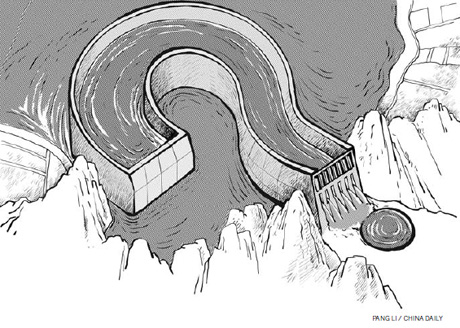Top News
Debate: Hydropower
Updated: 2011-06-07 08:00
(China Daily)

Should China go ahead with its plan to develop the hydropower sector? It definitely should, says an expert, while a professor of ecology and microbiology disagrees.
Zhang Boting
Hydroelectricity best for the environment
Hydroelectric power is the only renewable energy that can be used for large-scale economic development. The distinguishing feature of renewable energy is that it is inexhaustible and would be wasted if we do not exploit it.
No wonder, almost all developed countries have prioritized the use of hydro-energy and try to save as much fossil fuels as possible for later generations. It has been proven that the earlier hydroelectric power is developed, the less fossil fuel would be consumed and the less damage would be caused to the environment.
After the marketization reform of China's hydropower sector, its development has been under constant pressure from some extreme environmental protection forces. Some hydropower corporations lack experience in dealing with the media. Taking advantage of this, some media outlets have demonized China's hydropower sector. The result: the development of the original inexhaustible clean energy sector has been wrongly depicted as the prime reason for the destruction of the environment. But the higher the level of hydropower development, the better it is for the environment.
The large reservoirs, which prevent floods and supply water to dry areas throughout the year, have been maliciously blamed for cutting off rivers and aggravating the water crisis. Take the Three Gorges Dam as an example. It has drawn unjustified criticism because it is the largest hydropower project in the world. But it is the capacity of a hydropower project's reservoir rather than its power generating capacity that determines its impact on the adjoining environment.
The fact is that although the Three Gorges Dam is the largest hydropower project, it does not have the world's largest reservoir. More than 20 larger reservoirs have been built before the Three Gorges Dam, some of which are several times or even dozens of times larger and should have had a huge impact on the environment. This is to say that a large reservoir, not a project's power generating capacity, aggravates climate change to a large extent, and the Three Gorges Dam does not have a relatively large reservoir.
Media reports demonizing China's hydropower projects have misled the public and even influenced some decision-making departments of the government. As a result, some hydropower projects, including the one on the Nujiang River, have been delayed by years. For example, the hydropower project on the Jinsha River was halted during the 11th Five-Year Plan (2006-2010), but it turned out that rumors had hindered it. Because of the damaging reports many major large-scale hydropower projects have faced problems over the past few years, which curbed the government's capacity to manage water resources.
It is the shortage of important reservoirs to manage rivers' flow that has made China vulnerable to natural disasters like frequent floods and serious droughts along with water shortage and pollution.
The severe drought in South China, caused by insufficient reservoirs, has created a series of problems. And although the Three Gorges Dam will release 5 billion cubic meters of water downstream, we need to realize that its capacity is limited. Torrential rain has greatly eased the severe drought in central China, but it has also caused flooding in some regions. Some critics say big dams are useless, because they cannot combat droughts or floods. However, climate change has had a huge impact on the world, and China is no exception. It is the delay in building hydropower projects that has hindered China's capacity to deal with floods and droughts.
The Hutiaoxia or the Tiger Leaping Gorge project, planned as a key reservoir to manage the water resources of the Yangtze River, has been delayed by many years because it was very difficult to relocate the huge local population. But if the Hutiaoxia project is built on schedule and operates along with the Three Gorges Dam and other middle- and small-sized water conservancy projects, droughts in many areas can be combatted.
Since the hydropower sector was severely hampered during the critical period of China's fast economic development, it has lagged far behind the pace of the country's economic growth and its energy supply couldn't meet the existing demand.
Many countries have been calling for reduction in carbon emissions but China has to continue extracting more coal - up to 3 billion tons a year - damaging the environment further. The strong reliance on coal also leads to frequent social, economic and environmental problems such as lower coal output, transportation hindrances, frequent mine accidents and environmental damage.
The reliance on traditional energy such as coal put China under pressure at the Copenhagen Climate Change Conference and made the international community criticize the country's economic growth level.
The Chinese government has made a promise to the international community that it would raise the proportion of non-fossil fuel use to 15 percent and cut carbon intensity per GDP by 40 to 45 percent by 2020 from the 2005 level. Given China's real conditions and resources, whether or not it can fulfill its commitment largely depends on the progress of hydropower development.
It cannot be ignored that China's underdeveloped hydropower sector not only seriously tarnishes its image, but also thwarts its capability to combat floods and droughts - and thus hinders its economic growth. Given the country's real conditions, only optimum exploitation of water resources can help it achieve comprehensive, harmonious and sustainable development.
The author is deputy secretary general of China Society for Hydropower Engineering.
Guy R. Lanza
Dam the rivers and face the consequences
China leads the world in urbanization with more than 665 million people driving an economic growth rate in excess of 9 percent. The rapid growth of China's interior and its policy to renew/upgrade energy production infrastructure provide ample opportunity for poverty reduction while still making substantial contribution to the fight against climate change.
To be successful, China must develop a mix of renewable energy options that are truly green and sustainable. Large hydropower projects do not provide sustainable energy infrastructure for China or any other nation.
Some groups in China claim that hydropower will provide clean energy and alleviate climate change, for it reduces the use of fossil fuel. But pitting rivers against fossil fuels is a lose-lose proposition. The truth is that dams change the natural hydraulic function of rivers by destroying their natural flow dynamics, and the result is a cascade of negative environmental impacts.
The sudden seizure and storage of massive volumes of flowing water and sediment hasten the degradation of water quality, and reduce fish stock and invaluable biodiversity at a time when global water and food supplies are already under immense pressure. Besides, the sediment in dam reservoirs releases greenhouse gases, adding to the problem by contributing to climate change.
Contrary to common belief, controlling rivers' flow dynamics with dams does not provide a long-term solution to floods or droughts. Dams contribute to changes in regional hydrological cycles that combine with the more extreme patterns of weather associated with climate change and result in irregular episodes of flooding, drought and mud-slides.
Advocates of large hydroelectric projects, however, continue to perpetuate the myth of producing cheap, clean, renewable energy with little or no environmental and social costs. Experience shows that the opposite is true. Dam projects across the world have led to the loss of livelihoods of indigenous people and destruction of fisheries - an essential part of their culture and diets - and increased waterborne diseases. Schistosomiasis, already prevalent in the Yangtze River watershed, can increase following the impoundment of the river.
Hydropower projects in China are both numerous and massive in scale. And since the Three Gorges Dam on the Yangtze impounds the longest river in Asia, it is important for China to develop non-hydro options for energy.
China is poised to take the lead and set an example in intelligent planning to provide sustainable and renewable energy options to support its rapid economic and social development. But the plan must be comprehensive and should follow good models like the strategic environmental assessment - a process of appraisal that gives due consideration to environmental protection and sustainable development both. It integrates water resources management, too, which is an approach that combines and harmonizes key economic, social and environmental factors in a planning and management framework. The two approaches can be calibrated to provide sustainable options suitable for China.
To safeguard its rivers and their invaluable ecosystems, China should ensure that dam projects are selected using a basin-wide assessment of the river ecosystem with provisions to avoid harming threatened and endangered species. Before taking a decision to build a new dam, China should address outstanding social and environmental issues from existing dams, and maximize the benefits from existing projects.
Dam projects must provide for the release of environmental flows to help maintain healthy and productive downstream ecosystems. They should consider European Union and other effective global environmental impact assessment standards, and follow guidelines suggested by established expert groups. These groups strongly recommend that the cumulative environmental impact of hydroelectric projects at any scale must be given high priority in the planning process.
China should also take full advantage of the fact that global technology is close to the tipping point where solar energy will be competitive to fossil fuels and hydropower. A 2008 report of a United States-based academy of engineering panel predicts that we can reach solar grid parity in five years. Moving away from hydropower and toward renewable energy from a mix of decentralized options including solar, wind and geothermal is China's best option for long-term sustainable development.
Hydropower is only one source of energy for China and the rest of the world. The cheapest, cleanest and fastest solution is to make the use of energy more efficient. According to the McKinsey Global Institute, developing countries will account for about 80 percent of global energy growth up to 2020, and could cut their demand by more than half if they use existing technologies to improve energy efficiency. "This would leave energy consumption some 22 percent lower than it would otherwise have been - an abatement equivalent to the entire energy consumption of China today."
The author is a professor of aquatic ecology and microbiology at the University of Massachusetts.
(China Daily 06/07/2011 page9)
E-paper

Harbin-ger of change
Old industrial center looks to innovation to move up the value chain
Chemical attraction
The reel Mao
Improving app-iness
Specials

Vice-President visits Italy
The visit is expected to lend new impetus to Sino-Italian relations.

Birthday a new 'starting point'
China's national English language newspaper aims for a top-notch international all-media group.

Sky is the limit
Chinese tycoon conjures up green dreams in Europe with solar panels
